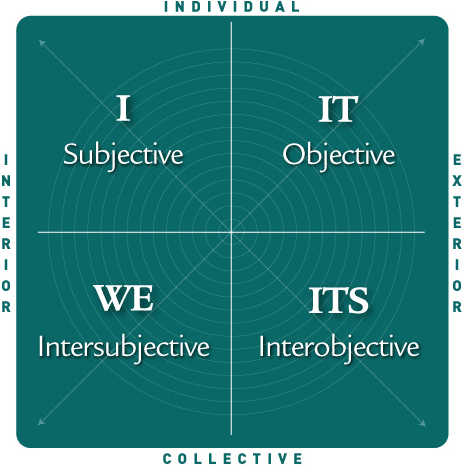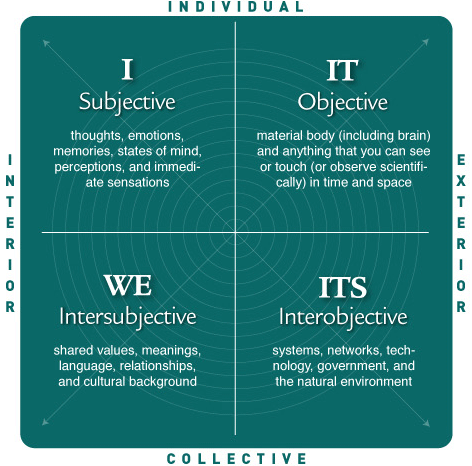Everything we feel is information, and it ping pongs between our inner and outer world. Our perception dictates how we react to that information, and our reaction dictates our emotions. So, it seems like being aware of our perception is the only thing that puts the power back in our hands when it comes to our emotions.
I ran into the Integral Theory by Ken Wilber, and found The Four Quadrants, let's just say the rabbit hole went very deep. I will attempt to keep this short and digestible, this shit is SO incredible.
What is the integral theory?
It is essentially a map bringing together more than a hundred theories in philosophy, psychology and sociology. Instead of finding the "one correct view", this "metatheory" tries to create a framework for taking into consideration the perspective of each philosophical tradition and understanding how they relate to one another through this map.
The Four Quadrants explain how there are always four distinctive ways to look at our present, four ways to interpret our reality.
The main focus on practicing perspective shifting is to:
- Take necessary distance from a situation.
- De-attach from thoughts that seem to hold the absolute truth and understand that there's always three more perspectives.
- Expand our ability to discern what is subjective, and what is objective.
- Consider if we tend to focus on one quadrant (perspective) and ignore others.
Why is this relevant?
For example: to the question of what is more "real" between the brain or the mind, this theory answers: both.
While some might like to reduce reality to the brain and it's neuroscience (It-objective), and others to the mind and its thoughts (I-subjective), Integral Theory holds that all quadrants are essential; the more we can bring awareness to these perspectives, the more comprehensive and balanced we can be with our actions and reactions.
The four quadrants
To sum it all up there are two "axis" to perceive the reality from:
- An inside or outside perspective - interior view (subjectivity) OR an exterior view (objectivity).
- from an individual or collective perspective - individuality OR collectivity.

Let’s explore each of them:
I - subjective
individual, interior experiences.
In the upper left we find our inner world and everything that has to do with the Self: our thoughts, feelings, memories, states of mind, intuition, perceptions, and immediate sensations.
Think of it as your first-person experience of being; our conscious mind going “I feel this, I need that”. This quadrant is often explored through introspection and it’s subjective in a sense that is completely biased by interpretation of our personal thoughts.
Let’s take children for example, this first-person perspective is the only view they have. They live from within their subjective experience; what they think, feel and desire is the only world that exists.
The matter with this quadrant is that most of us assume is the only perspective we hold when observing a situation, “too deep in your head” classic scenario. How thoroughly are you following a thought to the point that you believe your interior world is all there is? Can you go beyond thought?
We - intersubjective
collective, interior experiences
The lower-left represents the common world of meanings within groups and cultures: the shared values we have in a community, meanings, language, relationships, expectations and cultural backgrounds.
This view connects our inner world (I) with our collective perspective (we).
I believe this view contextualizes situations: perception is inherently socially constructed, much of our meaning is created and conveyed through language and society, which are social constructs.
How much of your reaction to a situation is being influenced by your background? And most pivotal: are you feeling the way you do because society wants you to feel that way?
The next step after going beyond thought, is to go beyond language.
IT - objective
individual, exterior things
In the upper-right we find our material body and what we can see or touch in time and space, and it connects the external world with our individual, material/objective perspective.
This view is objective in a sense that it considers that which is observable from the third-person perspective. Think of it as things that can be captured by a video. You can’t record thoughts (I - subjective), but you can record the behavior to those thoughts.
Taking an objective, third-person view in attempt to explain behavior can be extremely helpful to zoom out of situations. Stepping out of the interior experience and into the exterior view to see the whole picture.
Going beyond thought and simply observing the behavior to that thought instead. Some people call this “third-personing” and it is one of the tools that I use the most to navigate intense feelings and situations.
To be even more objective: after all we are all mammals with a cocktail of hormones and molecules that regulate the way we behave.
ITS- interobjective
collective, exterior things
Finally, in the lower-right we find the “outside world”: systems, networks, technology, government, cosmology and the natural environment. It connects the external world with the collective.
Social systems and how social systems operate from the third-person perspective. Think of it as zooming out even further, and observing the insignificance of thought in comparison to the whole cosmos.
This is another form of “third-personing” that takes it a step further: in relationship to our planet, our galaxy, our universe, is that thought really that loud in your head? And, does it actually matter?
p.s: it probably doesn't.

Practice
I invite you to take a moment to integrate this information and reflect on how the simple fact of being aware of these perspectives can guide you the next time you find yourself deep in your head.
Thank you for reading!
Bibliography
Thomas J. McFarlane (2000) A Critical Look at Ken Wilber’s Four Quadrant Model
Integral Academy: about Integral Theory
Marquis, A. (2007) The Integral Intake: A Guide to Comprehensive Idiographic Assessment in Integral Psychotherapy, Routledge.
Wilber, K. (2000). A theory of everything: An integral vision for business, politics, science, and spirituality. Boston, MA: Shambhala.



